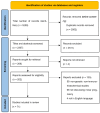Molecular Basis of Hydatidiform Moles-A Systematic Review
- PMID: 39201425
- PMCID: PMC11354253
- DOI: 10.3390/ijms25168739
Molecular Basis of Hydatidiform Moles-A Systematic Review
Abstract
Gestational trophoblastic diseases (GTDs) encompass a spectrum of conditions characterized by abnormal trophoblastic cell growth, ranging from benign molar pregnancies to malignant trophoblastic neoplasms. This systematic review explores the molecular underpinnings of GTDs, focusing on genetic and epigenetic factors that influence disease progression and clinical outcomes. Based on 71 studies identified through systematic search and selection criteria, key findings include dysregulations in tumor suppressor genes such as p53, aberrant apoptotic pathways involving BCL-2 (B-cell lymphoma), and altered expression of growth factor receptors and microRNAs (micro-ribose nucleic acid). These molecular alterations not only differentiate molar pregnancies from normal placental development but also contribute to their clinical behavior, from benign moles to potentially malignant forms. The review synthesizes insights from immunohistochemical studies and molecular analyses to provide a comprehensive understanding of GTD pathogenesis and implications for personalized care strategies.
Keywords: choriocarcinoma; complete molar pregnancy; gestational trophoblastic disease; hydatidiform mole; molecular basis of molar pregnancy; partial molar pregnancy.
Conflict of interest statement
The authors declare no conflicts of interest.
Figures
References
-
- Bruce S., Sorosky J. Gestational Trophoblastic Disease. StatPearls; Treasure Island, FL, USA: 2024. [(accessed on 26 June 2024)]. Available online: https://www.ncbi.nlm.nih.gov/books/NBK470267/ - PubMed
Publication types
MeSH terms
Substances
LinkOut - more resources
Full Text Sources
Medical
Research Materials
Miscellaneous




